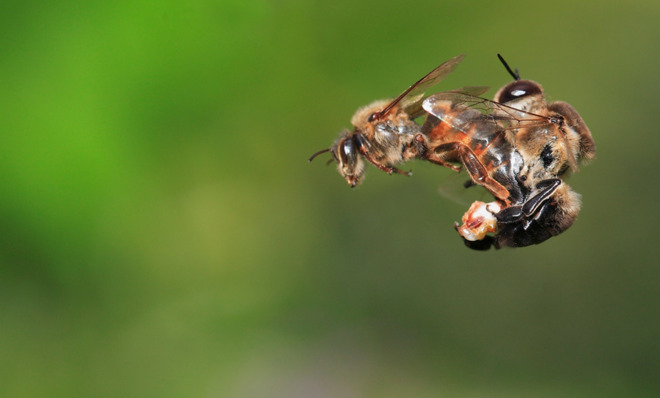Inside nature's most painfully bizarre sexual ritual
It involves sex-reversed genitalia and a barbed, inflatable member

For even the friskiest humans, the sex lives of animals can be pretty bizarre (see: spiders' detachable genitals or bees' suicidal mating habits). But a quartet of newly discovered species takes that weirdness up another notch.
Meet the four members of Neotrogla, a genus of insect that lives in the caves of the Brazilian rainforest. These little guys have marathon sex sessions that can last two to three days straight, but it's not just their tantric-like stamina that makes them odd. The naughty bits they use are mixed up.
All four species have sex-reversed genitalia. The females sport protruding, penis-like organs called gynosomes, while the males boast a vagina-like "genital chamber" instead of an external member. For them, copulation works pretty much the opposite way of how it does for other animals: the female penetrates the male with her gynosome to receive a bundle of sperm and nutrients.
The Week
Escape your echo chamber. Get the facts behind the news, plus analysis from multiple perspectives.

Sign up for The Week's Free Newsletters
From our morning news briefing to a weekly Good News Newsletter, get the best of The Week delivered directly to your inbox.
From our morning news briefing to a weekly Good News Newsletter, get the best of The Week delivered directly to your inbox.
The females aren't exactly delicate lovers, either. The gynosome is covered in tiny spines, and once it's inserted, the female inflates it and anchors herself inside her mate. The grip is strong enough that when one researcher tried to separate two bugs in the middle of the action, the gynosome stayed put but the male's abdomen was torn away from the rest of his body. (At least he died happy?)
How did sex get so backwards for these bugs? The scientists who discovered them think it has to do with those nutrients that the males deliver along with their sperm. The caves the insects live in are dry and poor in resources, their diet limited to bat droppings and the occasional bat carcass. For the females, mating means getting a meal, so the insects developed a unique sexual dynamic. The males are the choosier sex, while the females are more promiscuous and compete with each other for mates and the nutrition that they provide.
With the sexual conflict flipped to the female side, a reversal in genitals followed. The gynosome and its spines allow the females to literally grab a mate, control their copulation, and hang on to him until she gets what she came for.
That explanation is not set in stone, though, and the researchers say that "the evidence for reversed sexual selection and sexual conflict…is mostly circumstantial." To test their ideas, the scientists will have to do more controlled studies with the insects to get a better handle on their behavior and anatomy.
A free daily email with the biggest news stories of the day – and the best features from TheWeek.com
But for now, it's the Neotrogla females that seem to have the best grip on things.
-
 Could smaller cars bring down vehicle prices?
Could smaller cars bring down vehicle prices?Today’s Big Question Trump seems to think so, but experts aren’t so sure
-
 2025’s most notable new albums
2025’s most notable new albumsThe Week Recommends These were some of the finest releases of the past year
-
 Trump aims to take down ‘global mothership’ of climate science
Trump aims to take down ‘global mothership’ of climate scienceIN THE SPOTLIGHT By moving to dismantle Colorado’s National Center for Atmospheric Research, the White House says it is targeting ‘climate alarmism’